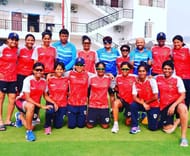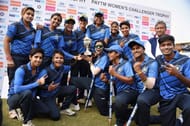
Indian women's cricket has seen a lot of reforms in the structure from bottom to the highest level since the finals of women's World Cup 2017. That event was very much responsible for triggering the rise of women's cricket in many parts of the country irrespective of small or big.
However, by all means, it was a breakthrough event from Women in Blue. They received the due recognition. Although, there were certain other achievements they received off the field like unprecedented coverage in the country, respect among the cricket fraternity, and the international acknowledgement were a few of them.
All in all, it worked out well for Indian women cricket. They were successful enough in registering themselves into the minds of male chauvinist administration. They forced BCCI to think beyond conventional, and planned out some significant strategies for the upliftment of women's cricket in India.
As a result, BCCI, the national governing body for cricket in India, showered its love with 'many firsts' for women's cricket. Best of the things that happened to women's cricket in India in 2018 are discussed below.
#5 Introduction of nine new teams
On the day of the domestic calendar announcement, BCCI came up with a very fine decision of including more teams. Earlier, there were 27 teams, and with the inclusion of nine more teams, it became a total of 36 teams participating in the domestic tournaments.
The teams from the Arunachal Pradesh, Bihar, Manipur, Meghalaya, Mizoram, Nagaland, Puducherry, Sikkim and Uttarakhand were the new addition to the Indian domestic cricket.
With the introduction of more teams, BCCI also made sure they don't complicate the existing structure rather keep it simple. They merged all Plate groups into one and placed all new teams into that. Elite Group A, B and C were extended to nine teams each. So, finally four groups with nine teams each.
Ultimately, teams, those were getting four to five games in their group would get eight games at least. More teams, more games and more exposure.
#4 Increment in match fee for domestic players

An unbelievable 200% hike in each category for men and women, was among the most proactive steps taken by BCCI in 2018. Players, play their heart out on the field, train throughout the year, and maintain their fitness to not miss out on a single opportunity which could lead them to their dream, they deserve better pay.
As far as the revised pay grade is concerned a senior player, who makes it to playing XI would receive INR 12,500 and the ones in reserve would get INR 6250 the players in U-23, U-19 & U-16 playing XI players would receive INR 5500 and the ones in reserve will get INR 2750.
A handful of incentives always motivate players to do good. With more money in their pocket, they would be more relaxed off the field and aspire to do better with every season.
#3 Extension of domestic structure for women

The highlight of the BCCI's declaration of the 2018-19 domestic calendar was, 'the scrapping of three-day Inter-Zonal event'. Instead, BCCI accommodated several other tournaments for the first time to the women's domestic portfolio.
Removal of the three-day tournament from the calendar wasn't a bad idea though. As the popularity of one-day and T20 cricket at the world stage is phenomenal and its yielding better results for the boards. So, it is a better idea to stick with it.
Moreover, there is hardly any country organising Test cricket for them. As far as my memory goes, the only Test played this year was during the Australian summer between Australia and England.
Coming back to the BCCI, it carried out its homework really well and proposed some new tournaments to strengthen the grassroots. They proposed, a T20 and ODI league along with a Challenger Trophy for the U19 & U23 women. Earlier, only ODI league at the Zonal level was used to feature in domestic calendar.
In addition, a T20 Challenger Trophy for the senior women was the first event, earlier this year BCCI introduced for the first time, ahead of the World T20. The event got a good response.
Where U16 women cricket is yet to find its place in the domestic calendar, BCCI have a huge task ahead of the next year's calendar declaration.
#2 Live broadcast for women's international matches

Despite doing so much for the country, Women in Blue always struggled to get broadcasters to their games. India vs England women’s matches at Nagpur is still fresh in our memory.
ICC, the global governing body of cricket, played a significant part in increasing the global interest in women's cricket. 2017 World Cup was broadcasted and live streamed across 139 countries, whereas the standalone World T20 across more than 200 countries. The hunger could be clearly visualised from the increase in number in just a space of one year.
And India, as the top-notch contributor to the viewership, BCCI didn't want to miss on the opportunity. April 2018, Star India Pvt. Ltd. played the biggest gamble of its corporate career and bagged BCCI's media rights for domestic as well as international games for Rs. 6138.50 crores.
They already telecasted the Challenger Trophy and one can expect them to telecast more tournament in the coming days.
#1 Central contracts for Indian women
It had been over ten years since the Women's Cricket Association of India merged with the BCCI yet, whenever the BCCI announced its annual contracts to its players, no one ever heard about the women. Of course, because they were always kept stranded of the central annual contracts.
It was the first time for the Indian female cricketers in the last 12 years since the merger, to feel proud of playing for the richest cricket board in the world. India's top-flight women cricketer, with a stroke of a pen, became the highest-paid cricketers in the world.
BCCI distributed central contracts to women players in three different categories A, B & C where Grade A players would get Rs 50 lakh, Grade B Rs 30 lakh and Grade C Rs 10 lakh. Mithali Raj, Harmanpreet Kaur, Jhulan Goswami and Smriti Mandhana, were given Grade A contracts. BCCI gave out 19 contracts in total.
Looking for fast live cricket scores? Download CricRocket and get fast score updates, top-notch commentary in-depth match stats & much more! 🚀☄️
